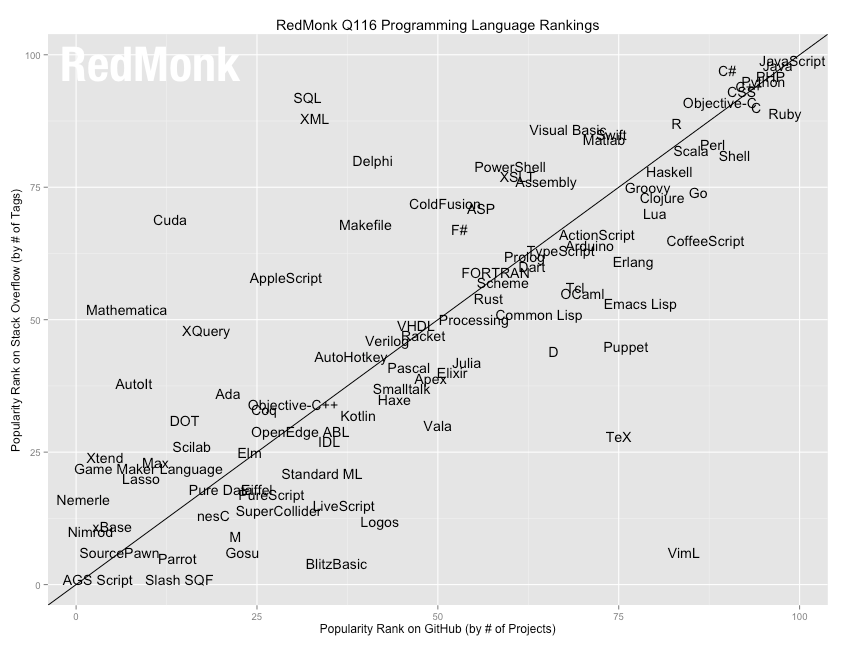 JavaScript and Java continue to dominate developers’ minds and time, according to a new ranking of programming languages by tech-industry analyst firm RedMonk. RedMonk calculates its ranks based on GitHub and Stack Overflow. “The idea is not to offer a statistically valid representation of current usage, but rather to correlate language discussion (Stack Overflow) and usage (GitHub) in an effort to extract insights into future trends,” reads the firm’s explanation of its methodology. Based on that methodology, RedMonk lists programming languages as follows:
JavaScript and Java continue to dominate developers’ minds and time, according to a new ranking of programming languages by tech-industry analyst firm RedMonk. RedMonk calculates its ranks based on GitHub and Stack Overflow. “The idea is not to offer a statistically valid representation of current usage, but rather to correlate language discussion (Stack Overflow) and usage (GitHub) in an effort to extract insights into future trends,” reads the firm’s explanation of its methodology. Based on that methodology, RedMonk lists programming languages as follows:
- JavaScript 2. Java 3. PHP 4. Python 5. C# 5. C++ 5. Ruby 8. CSS 9. C 10. Objective-C 11. Shell 12. Perl 13. R 14. Scala 15. Go 15. Haskell 17. Swift 18. Matlab 19. Clojure 19. Groovy 19. Visual Basic
In its explanation, RedMonk remains unsurprised by the top rankings of JavaScript and Java: “In many cases, Java and JavaScript are leveraged side-by-side in the same application, depending on its particular needs.” The rest of the top-ten entries on the list are “similarly static,” something the firm views as “the expectation rather than a surprise.” Simply put, the biggest languages can’t grow much more, and their ubiquity also makes it difficult for them to tumble quickly. (The exception is the Objective-C programming language for iOS and Mac OS X development, which has plunged in virtually every ranking since Apple eclipsed it with the newer, shinier Swift.) Further down the list, languages have the opportunity to rise—and fall—several spots over the course of the year. RedMonk has called out Rust, Elixir, Julia, Typescript, and (of course) Swift as ones to watch. While some of these won’t experience explosive growth over the next few years, they may achieve slow-but-steady gains as more developers use them on projects. Next: The Reason for Java's Dominance (click below)  Just for comparison, here’s the TIOBE Index of February’s most popular programming languages, pulled from search-engine data:
Just for comparison, here’s the TIOBE Index of February’s most popular programming languages, pulled from search-engine data:
- Java 2. C 3. C++ 4. C# 5. Python 6. PHP 7. Visual Basic .NET 8. Perl 9. JavaScript 10. Delphi/Object Pascal 11. Ruby 12. Visual basic 13. Assembly Language 14. Objective-C 15. D
Of particular note is how, on TIOBE’s list, JavaScript places a respectable-but-unspectacular ninth. Contrast that with RedMonk, where it sits firmly in top place. Obviously developers are downloading and discussing the language (placing it high with RedMonk) but not searching for it quite as much as other programming languages (which would have placed it higher on TIOBE). Java, however, continues to comfortably dominate both lists. Why does Java continue its spectacular run, more than twenty years after its creation? When the language made its debut in May 1995 (as Java 1.0a2 with the HotJava browser), it’s questionable whether any of its creators at Sun Microsystems thought it would have such a long lifespan ahead of it. But as with most enduring languages and software platforms, Java had the good luck of becoming the go-to tool for developers building a wide variety of products, including (in Java’s case) everything from Web services to enterprise software products. Given its degree of integration into the modern cloud, it’s likely that Java will endure for many years to come—no matter who’s compiling the rankings.



